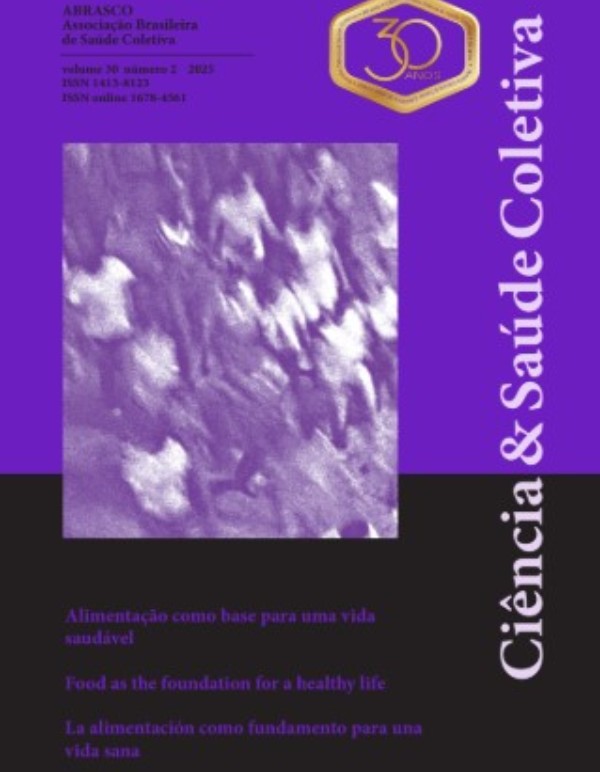0417/2023 - Uso de dietas especiais no Brasil: II Inquérito Nacional de Alimentação 2017-2018
Use of special diets in Brazil: II National Food Survey 2017-2018
Autor:
• Beatriz Salari Bortolot - Bortolot, B. S. - <bia_salari@hotmail.com>ORCID: https://orcid.org/0000-0003-2895-874X
Coautor(es):
• Eliseu Verly Junior - Verly Junior, E. - <eliseujunior@gmail.com>ORCID: https://orcid.org/0000-0002-1101-8746
• Marina Araujo - Araujo, M. - <mcamposaraujo@gamil.com>
ORCID: https://orcid.org/0000-0002-7980-6618
Resumo:
O objetivo do presente estudo foi estimar a prevalência do uso de dietas especiais e analisar o perfil sociodemográfico, o estado nutricional e uso de sal, açúcar e adoçantes em brasileiros que realizam dietas especiais. Trata-se de um estudo transversal utilizando dados do segundo Inquérito Nacional de Alimentação 2017/2018 (n=45.689 indivíduos com pelo menos 10 anos de idade). Foi questionado o uso de dietas para hipertensão, diabetes, colesterol, doença do coração e para emagrecer. Foi estimada a prevalência do uso de dietas de acordo com características sociodemográficas e estado nutricional, e modelos de regressão logística foram utilizados para avaliar os fatores associados à realização de dietas. Todas as análises consideraram o desenho da amostra e os fatores de expansão. A prevalência do uso de dietas especiais foi de 14,3%, sendo as dietas para emagrecer (5,2%) e pressão alta (4,6%) as mais prevalentes. As mulheres, idosos, indivíduos de maior renda e com obesidade tiveram maiores chances de realizarem qualquer tipo de dieta especial quando comparados aos seus pares.Palavras-chave:
Dietas especiais; Inquérito Nacional de Alimentação; Nutrição.Abstract:
The objective of the present study was to estimate the prevalence of the use of special diets and to analyze the sociodemographic profile, nutritional status and eating habits of the Brazilian population that uses special diets. This is a cross-sectional study using data from the second National Food Survey 2017/2018 (n=45,689 individuals aged at least 10 years). The use of diets for hypertension, diabetes, cholesterol, heart disease and weight loss were questioned. The prevalence of diet use was estimated according to sociodemographic characteristics and nutritional status, and logistic regression models were used to assess factors associated with dieting. All analyzes considered sample design and expansion factors. The prevalence of the use of special diets was 14.3%, with diets for weight loss (5.2%) and high blood pressure (4.6%) being the most prevalent. Women, the elderly, individuals with higher incomes and those with obesity were more likely to follow any type of special diet when compared to their peers.Keywords:
Special diets. National Food Survey. Nutrition.Conteúdo:
Acessar Revista no ScieloOutros idiomas:
Use of special diets in Brazil: II National Food Survey 2017-2018
Resumo (abstract):
The objective of the present study was to estimate the prevalence of the use of special diets and to analyze the sociodemographic profile, nutritional status and eating habits of the Brazilian population that uses special diets. This is a cross-sectional study using data from the second National Food Survey 2017/2018 (n=45,689 individuals aged at least 10 years). The use of diets for hypertension, diabetes, cholesterol, heart disease and weight loss were questioned. The prevalence of diet use was estimated according to sociodemographic characteristics and nutritional status, and logistic regression models were used to assess factors associated with dieting. All analyzes considered sample design and expansion factors. The prevalence of the use of special diets was 14.3%, with diets for weight loss (5.2%) and high blood pressure (4.6%) being the most prevalent. Women, the elderly, individuals with higher incomes and those with obesity were more likely to follow any type of special diet when compared to their peers.Palavras-chave (keywords):
Special diets. National Food Survey. Nutrition.Ler versão inglês (english version)
Conteúdo (article):
USO DE DIETAS ESPECIAIS NO BRASIL: II INQUÉRITO NACIONAL DE ALIMENTAÇÃO 2017-2018USE OF SPECIAL DIETS IN BRAZIL: II NATIONAL FOOD SURVEY, 2017-2018
AUTHOR: Beatriz Salari Bortolot - BORTOLOT, B. S. - Instituto de Medicina Social Hesio Cordeiro – UERJ - bia_salari@hotmail.com – ORCID: https://orcid.org/0000-0003-2895-874X
Co-Authors:
Eliseu Verly Junior - VERLY JR, E. – Instituto de Medicina Social Hesio Cordeiro – UERJ - eliseujunior@gmail.com – ORCID: https://orcid.org/0000-0002-1101-8746
Marina Campos Araujo - ARAUJO, M. C. – Fundação Oswaldo Cruz - mcamposaraujo@gamil.com – ORCID: https://orcid.org/0000-0002-7980-6618
RESUMO
O objetivo do presente estudo foi estimar a prevalência do uso de dietas especiais e analisar o perfil sociodemográfico, o estado nutricional e uso de sal, açúcar e adoçantes em brasileiros que realizam dietas especiais. Trata-se de um estudo transversal utilizando dados do segundo Inquérito Nacional de Alimentação 2017/2018 (n=45.689 indivíduos com pelo menos 10 anos de idade). Foi questionado o uso de dietas para hipertensão, diabetes, colesterol, doença do coração e para emagrecer. Foi estimada a prevalência do uso de dietas de acordo com características sociodemográficas e estado nutricional, e modelos de regressão logística foram utilizados para avaliar os fatores associados à realização de dietas. Todas as análises consideraram o desenho da amostra e os fatores de expansão. A prevalência do uso de dietas especiais foi de 14,3%, sendo as dietas para emagrecer (5,2%) e pressão alta (4,6%) as mais prevalentes. As mulheres, idosos, indivíduos de maior renda e com obesidade tiveram maiores chances de realizarem qualquer tipo de dieta especial quando comparados aos seus pares.
Palavras-chave: Dietas especiais. Inquérito Nacional de Alimentação. Nutrição.
ABSTRACT:
This study aims to estimate the prevalence of special diets and analyze the sociodemographic profile, nutritional status, and eating habits of the Brazilian population that uses special diets. This cross-sectional study was conducted with data from the second 2017/2018 National Food Survey (n=45,689 individuals aged at least 10 years). We questioned the use of hypertension, diabetes, cholesterol, heart disease, and weight-loss diets. Dieting prevalence was estimated by sociodemographic characteristics and nutritional status, and logistic regression models were employed to assess factors associated with dieting. All analyses considered sample design and expansion factors. The prevalence of special diets was 14.3%. Weight-loss (5.2%) and hypertension (4.6%) diets were the most prevalent. Women, older adults, individuals with higher incomes, and obese individuals were more likely to follow any type of special diet than their peers.
Keywords: Special diets. National Food Survey. Nutrition.
INTRODUCTION
Global Burden of Disease study data estimated that chronic non-communicable diseases (NCDs) were responsible for 74% of all deaths worldwide in 20191. In 2018, according to data from the Ministry of Health (MS), the four main groups of NCDs (cancer, diabetes, and lung and cardiovascular diseases) were responsible for 55% of all deaths in Brazil. In most NCDs, higher mortality rates were observed among men, adults, and older adults. Men had the highest risk of premature death from NCDs and the highest risk observed for cardiovascular diseases (166 per 100,000 individuals)2.
Lifestyle changes, particularly in diet, are essential strategies for controlling NCDs and their risk factors, reducing the risk of premature mortality3-5. In this sense, adopting special diets is associated with healthier food choices. It is usually part of the guidelines prescribed by health professionals for individuals with NCDs, both for treatment and the prevention of unfavorable health outcomes6. The Mediterranean diet, to reduce major cardiovascular disease events, and the DASH diet, to reduce hypertension and cholesterol levels7-9, stand out among the evidence supporting specific diets to improve health and reduce symptoms of chronic diseases.
Among the few studies that have evaluated the use of special diets in populations6,9-12, differences were observed regarding the characteristics of the individuals, such as gender, age group, and nutritional status11,12. Considering that the occurrence of NCDs is more frequent in certain strata of the population, such as individuals who are overweight, older, and in worse socioeconomic conditions13, knowing the distribution of the use of different types of diets according to these characteristics allows us to assess the scope of dieting to control NCDs in the highest-risk groups.
No nationally representative study has been identified assessing the prevalence of special diets in the Brazilian population. In this context, this study aimed to estimate the prevalence of special diets in the Brazilian population and analyze the association between sociodemographic profile and nutritional status using special diets in the Brazilian population based on data from the II National Food Survey of 2017-2018. Furthermore, we evaluated added salt, sugar, and sweeteners among individuals following special diets. These variables will be used as diet adherence markers since they are components usually addressed in different special diets.
METHODS
We employed diet characteristics module data collected in the second National Food Survey (INA), which corresponds to the Personal Food Consumption Block of the Consumer Expenditure Survey (POF) conducted by the Brazilian Institute of Geography and Statistics (IBGE) from 2017 to 2018. In all, 57,920 households were selected for the 2017-2018 POF. The sample for the INA corresponded to 34.7% of the households sampled for the 2017-2018 POF, totaling 20,112 selected households. All residents at least 10 years of age in the 20,112 sampled households answered the questions regarding using special diets, totaling 46,164 individuals14. This study excluded Yellow and Indigenous individuals (n=475), leaving a total sample of 45,689 individuals.
Description of the variables
Implementing special diets – INA – POF 2017-2018
The variable investigated was obtained from the following questions in the Personal Food Consumption Block of the 2017-2018 POF:
• “Are you following any diet?”: “yes” or “no”
• “Diet for”: “weight loss”, “hypertension”, “cholesterol”, “diabetes”, “heart disease”, and “other needs”.
Respondents could report the condition of being subject to a diet that met multiple purposes; that is, they could check more than one option among the diets presented. There was no option to inform which diet referred to “another need”. The number of diet types was categorized as just one, two, and three or more to identify whether more than one special diet was being followed simultaneously.
Sociodemographic characteristics
Information was collected on gender (male and female); age, later categorized into adolescents (<20 years), adults (20 to 59 years), and older adults (60 years or older); race (White, Black, Yellow, Brown, or Indigenous); schooling and per capita household income.
Per capita household income was calculated as the total household income divided by the number of residents and converted to minimum wages per the value in effect during the study reference period (BRL 954.00, January 2018). It was then categorized as “≤0.5 minimum wage per capita”, “>0.5 and ≤1”, “>1 and ≤2”, “>2 and ≤3”, “>3 and ≤4”, and “>4”.
The schooling level was assessed by the question “What was the highest schooling level you previously attended?” The following categories were used: Primary education, Ninth grade, High School, and Higher Education and above.
For the race variable, the response options were: “White”, “Black”, “Brown”, “Yellow”, or “Indigenous”. The last two options were not included in the analyses because they had a low percentage (1.2%) in the sample.
Nutritional status
Body Mass Index (BMI) was calculated from self-reported weight and height. The cutoff points recommended by the World Health Organization (WHO, 1998)15 for adults and older adults were used, considering <18.5 kg/m2 (underweight), >18.5 to 24.9 kg/m2 (adequate weight), ≥25 to 29.9 kg/m2 (overweight) and >30.0 kg/m2 (obese). For adolescents, we adopted the BMI values in z-score for age and gender recommended by the WHO (2007)16, using the WHO Anthro-Plus Software version 1.0.4, considering the following BMI index classifications for age: z-score < -2 (underweight), z-score ≥ -2 and z-score < 1 (eutrophy), z-score ≥ 1 and z-score < 2 (overweight), and z-score ≥ 2 (obese).
Added salt, sugar, and sweetener
The questionnaire also included questions about the use of added salt (whether the respondent had the habit of adding salt to their food) and added sugar (whether the most frequent use was sugar, sweetener, or both). The respondent could indicate “yes” or “no” for the added salt variable. For the added sugar and sweetener variable, the respondent could indicate the use: i) only sugar, ii) only sweetener, iii) sugar and sweetener. For this study, the use of only sugar and only sweetener was considered.
Statistical analysis
The prevalence and respective 95% confidence intervals of special diets and their purpose (weight loss, hypertension, diabetes, cholesterol, and heart disease) were estimated by age group and gender, nutritional status, income strata, schooling, and race. Moreover, the prevalence and 95% confidence interval of added salt, sugar, and sweeteners were estimated by type of special diet. Statistically significant differences between the prevalence levels were considered when there was no overlap of their respective 95% CI.
Logistic regression models were used to assess factors associated with special diets, with one model for each dependent variable: i) following any type of diet; ii) hypertension diet; iii) weight-loss diet; and iv) diabetes diet. Each model was mutually adjusted for the following variables: gender, age group, nutritional status, per capita household income, schooling level, and race. The analyses were performed using R version 4.1.0 and SAS OnDemand for Academics, considering the complex sampling design and its expansion factors.
Ethical aspects
This study used a secondary database from the 2017-2018 Consumer Expenditure Survey14, which is publicly and unrestrictedly accessible. The microdata are freely available on the institution’s website (https://www.ibge.gov.br/estatisticas/sociais/populacao/24786-pesquisa-de-orcamentos-familiares-2.html?edicao=28523&t=sobre). Therefore, this work does not require assessment by the Research Ethics Committee.
RESULTS
The sample comprised primarily women (52.1%), adults (62.9%), brown (44.9%), eutrophic (45.5%), individuals with High School level (26.4%) and living in households with a per capita household income of one to two minimum monthly wages (31.6%) (Table 1).
Using special diets was reported by 14.3% of individuals. The prevalence was higher among women (17.8%; 95% CI 17.0-19.0) than men (9.6%; 95% CI 9.0-10.0); among older adults (27.3%; 95% CI 25.7-28.9) than other age groups; in higher-income individuals (22.7%; 95% CI 20.9-25.7) than lower-income stratum; and among obese individuals (21.6%; 95% CI 20.1-23.2) than other nutritional statuses. The highest prevalence of dieting was observed in less educated individuals (up to complete primary education) (Table 1).
Weight-loss diet was the most prevalent (5.2%; 95% CI 4.8-5.5) among the studied population (n=45,689), followed by hypertension (4.6%; 95% CI 4.3-5.0), diabetes (3.5%; 95%CI 3.3-3.8), cholesterol (2.9%; 95%CI 2.7-3.2) and heart disease diets (0.8%; 95% CI 0.7-0.9). Hypertension diet was more prevalent in men (3.7%; 95% CI 3.3-4.0), and weight-loss diet was more prevalent in women (7.4%; 95% CI 6.9-7.9).
The prevalence of any type of diet was higher among older adults, for men (22.4%; 95% CI 20.3-24.6) and women (31.2%; 95% CI 29.1-33.3), and hypertension and diabetes diets stood out in this age group. Weight-loss diet was the most prevalent among adults and adolescents for men and women. Among people on a diet, most of the study population (70.1%; 95% CI 69.1-72.7) stated that they followed only one type of special diet (Table 2).
There was a higher prevalence of different types of diet among overweight and obese individuals and those with higher income, and a decline among the more educated people. The exception was weight-loss diet, which was more prevalent among those with higher schooling levels, 10.4%; 95% CI 9.1-11.7, vs. 2.6%; 95% CI 1.8-3.5 in individuals with up to complete primary education. No defined dieting pattern was observed by skin color (Table 3).
Sugar use prevalence was lower among individuals who reported following any type of diet than those who did not follow any type of diet (men: 53.1%; 95% CI 49.7-56.5 vs. 85.4%; 95% CI 84.4-86.4; women: 51.1%; 95% CI 48.6-53.5 vs. 81.9%; 95% CI 80.8-82.9). However, sweetener use prevalence was higher among individuals who followed a diet, 28.2%; 95% CI 25.2-31.2 (men) and 28.4%; 95% CI 26.3-30.4 (women), against those who did not follow any type of diet, 4.5%; 95% CI 4.0-5.1 (men), and 6.7%; 95% CI 6.0-7.4 (women). This difference was more prevalent among individuals on a diabetes diet than those without one. Added salt was mainly less prevalent among those on a diet, especially among women (9.6%; 95% CI 8.4-10.9), with the lowest prevalence among individuals on a hypertension diet (men: 6.3%; 95% CI 3.8-8.8; women: 5.9%; 95%CI 4.3-7.5) (Table 4).
In the analysis with logistic regression models, older adults were more likely to use special diets than adults, except regarding weight-loss diets. The most significant magnitudes of associations were observed concerning hypertension and diabetes diets (OR=3.9; 95% CI 3.2-4.7 and OR=4.7; 95% CI 3.8-5.8, respectively). Obese individuals were more likely to follow the different types of diets tested, with the most significant association observed for weight-loss diets (OR=4.2; 95% CI 3.4-5.0).
The effect of income on adopting any diet was generally observed in almost all categories compared to the lowest income group. No differences were observed between income groups, specifically regarding hypertension and diabetes diets. More educated individuals were more likely to follow a weight-loss diet. On the other hand, those with lower schooling levels were more likely to follow hypertension and diabetes diets (Table 5).
DISCUSSION
This study estimated that approximately 15% of the Brazilian population over 10 followed special diets, with weight-loss diets being the most prevalent, followed by hypertension, diabetes, cholesterol, and heart disease diets. In general, women, older adults, obese individuals, and individuals with higher incomes were more likely to follow diets than their peers.
It is already known that women tend to seek out health services more, which corroborates the higher dieting prevalence among women compared to men. According to the latest edition of the National Health Survey (PNS-2019), 82.3% of women visited a doctor within 12 months before the interview compared to 69.4% of men17. Furthermore, according to the PNS (2019)18, the proportion of NCD diagnoses increases with age, which explains the higher prevalence of dieting among older adults since this group needs more strategies to preserve health.
The higher prevalence of all types of diets among overweight and obese individuals can be partly explained by the greater attention to healthcare directed at these groups, given the increased risk of other comorbidities19,20. However, it represents a small percentage against the total number of overweight individuals, around 60%18. On the other hand, it also indicates an intention to change health status21, a positive diagnosis, albeit in a small portion of the population. Moreover, regardless of health-related issues, aesthetic motivations probably explain a considerable part of these results, especially among women22.
The second most reported diet in the study population was the high blood pressure diet (4.9%), mainly among older adults (11.6% among men and 17.2% among women). People diagnosed with hypertension are expected to receive some recommendations about their diet and can implement such guidelines to control this condition. In this study, we do not know whether the people on hypertension diets have been diagnosed with this condition (although it is pretty reasonable to assume that they have, at least for most of them). Likewise, we do not know whether all people diagnosed have received any guidance on adopting a diet.
In any case, the prevalence of hypertension diet observed is substantially lower than the estimated prevalence of hypertensive individuals in Brazil (23.9% of the population, 46% among older adults, according to the PNS)18, which implies that diet as an essential strategy for controlling hypertension is poorly used. A slightly more optimistic situation is observed for diabetes. According to the PNS, the prevalence of diabetes ranges from 6.6% to 9.4% of Brazilians, depending on the criteria used for diagnosis23, compared to approximately 4% of the population who reported using a diet for this purpose.
Lower use of salt and added sugar was observed among those who reported following diets, indicating the importance of these components in dietary guidelines. The nutritional quality of the diets was not assessed in this study. However, using special diets appears to have benefitted the population’s choice (and consequently consumption) of salt and sugar, items addressed in hypertension and diabetes diets, and relevant in controlling the respective diseases.
The higher likelihood of dieting among those with higher incomes follows the already-known effect of income on access to health services24. It is most likely that this group had greater access to diagnosis, professionals with the conditions and resources to guide nutrition, or even better conditions to follow the guidance received. However, it is noteworthy that the highest prevalence rates were generally observed among the less educated, particularly individuals with only primary education, even after adjusting for age group (considering that older adults have the highest prevalence of NCDs and those with lower schooling levels). One explanation is the higher prevalence of NCDs observed among less educated individuals13, which seems to be a relevant determinant regardless of income and age group.
Compared with similar international studies, the prevalence of diet use observed in Brazil was higher than in the United States, based on data from the 2012 National Health Interview Survey11, with 34,525 Americans over 18. Dieting prevalence was 7.5% among Americans. Most who followed special diets were female (60.6%), aged 50-64 (36.1%), with overweight and obese individuals (62.5%). Furthermore, the study found a higher prevalence of diet use in non-Hispanic white individuals (74.6%) and those with Higher Education (58.4%). A higher prevalence was also observed among those with a disease history, namely hypertension (30.3%), diabetes (10.4%), and some heart diseases (3.5%).
However, in another study conducted with the American population, the prevalence was closer to that observed in the present study. Stierman et al.12, using data from the National Center for Health Statistics (NCHS), observed that approximately 17% of North American adults aged 20 and above reported being on any type of special diet between 2015 and 2018, again with a higher percentage among women (19% among women vs. 15% among men). The prevalence was also higher among individuals aged 40-59 (19.2%) and 60 and above (19.3%). The percentage of adults on a special diet increased with education, which was not observed in the present study. The pattern of the most common types of special diets varied with age. However, the most common types of special diets considering all age groups were weight-loss or low-calorie diets.
We should underscore some limitations of the present study. The concept of what is understood as diet may vary among individuals, and it is impossible to know whether the diet in question represents a short- or long-term dietary change. There is no data to assess the necessary indication or previous diagnosis that justifies the purpose of the diet adopted. However, a strength of this study is that it is an unprecedented work at a national level, as it assesses the prevalence of special dieting in a representative sample of the Brazilian population.
In conclusion, approximately 15% of the population reported using some type of special diet, which was more frequent among women, older adults, overweight people, and more affluent individuals. The prevalence of hypertension and diabetes diets was substantially lower than the percentage of the population reporting a diagnosis of these conditions.
REFERENCES
1. World Health Organization. The Top 10 Causes of Death. Disponível em:
2. Brasil. Ministério da Saúde. Secretaria de Vigilância em Saúde. Departamento de Análise em Saúde e Vigilância de Doenças não Transmissíveis. Saúde Brasil 2020/2021: uma análise da situação de saúde e da qualidade da informação [recurso eletrônico] /Ministério da Saúde, Secretaria de Vigilância em Saúde, Departamento de Análise em Saúde e Vigilância de Doenças não Transmissíveis – Brasília: Ministério da Saúde, 2021.
3. Sofi F, Cesari F, Abbate R, Gensini GF, Casini A. Adherence to Mediterranean diet and health status: meta-analysis. BMJ [Internet]. 2008;337(sep11 2):a1344. Disponível em: http://dx.doi.org/10.1136/bmj.a1344
4. Benson G, Pereira RF, Boucher JL. Rationale for the use of a Mediterranean diet in diabetes management. Diabetes Spectr [Internet]. 2011;24(1):36–40. Disponível em: http://dx.doi.org/10.2337/diaspect.24.1.36
5. Campbell, Matthew (2017) The role of exercise and physical activity in obesity. New strategies to treat and prevent obesity. In: Practical Guide to Obesity Medicine. Elsevier. ISBN 9780323485593
6. Ahola AJ, Forsblom C, Groop P-H. Adherence to special diets and its association with meeting the nutrient recommendations in individuals with type 1 diabetes. Acta Diabetol [Internet]. 2018;55(8):843–51. Disponível em: http://dx.doi.org/10.1007/s00592-018-1159-2
7. Eilat-Adar S, Sinai T, Yosefy C, Henkin Y. Nutritional recommendations for cardiovascular disease prevention. Nutrients [Internet]. 2013;5(9):3646–83. Disponivel em: http://dx.doi.org/10.3390/nu5093646
8. Stradling C, Hamid M, Taheri S, Thomas GN. A review of dietary influences on cardiovascular health: part 2: dietary patterns. Cardiovasc Hematol Disord Drug Targets [Internet]. 2014;14(1):50–63. Disponível em: http://dx.doi.org/10.2174/1871529x14666140701095426
9. Leung B, Lauche R, Leach M, Zhang Y, Cramer H, Sibbritt D. Special diets in modern America: Analysis of the 2012 National Health Interview Survey data. Nutr Health [Internet]. 2018; 24(1):11–8. Disponível em: http://dx.doi.org/10.1177/0260106017732719
10. Lee CJ, Warren AP, Godwin S, Tsui JC, Perry G, Hunt SK. Impact of special diets on the nutrient intakes of southern rural elderly. Journal of the American Dietetic Association. 1993; 93(2).
11. Clarke TC, Black LI, Stussman BJ, Barnes PM, Nahin RL. Trends in the Use of Complementary Health Approaches Among Adults: United States, 2002–2012. Natl Health Stat Report. 2015 February 10; (79): 1–16.
12. Stierman B, Ansai N, Mishra S, Hales CM. Special diets among adults: United States, 2015-2018. NCHS Data Brief. 2020;(289):1–8
13. Hone T, Stokes J, Trajman A, Saraceni V, Coeli CM, Rasella D, Durovni B, Millett C. Racial and socioeconomic disparities in multimorbidity and associated healthcare utilisation and outcomes in Brazil: a cross-sectional analysis of three million individuals. BMC Public Health. 2021 Jul 1;21(1):1287. doi: 10.1186/s12889-021-11328-0. PMID: 34210313; PMCID: PMC8252284
14. Instituto Brasileiro de Geografia e Estatística (IBGE). Pesquisa de Orçamentos Familiares 2017-2018: Avaliação nutricional da disponibilidade domiciliar de alimentos no Brasil. Rio de Janeiro: IBGE; 2020.
15. Organização Mundial de Saúde OMS. Growth reference data for 5-19 years 2007. Disponível em: http://www.who.int/growthref/who2007_bmi_for_age/en/index.html
16. World Health Organization. Obesity: preventing and managing the global epidemic. Geneva: World Health Organization; 1998. (Technical Report Series, 894).
17. Cobo B, Cruz C, Dick PC. Desigualdades de gênero e raciais no acesso e uso dos serviços de atenção primária à saúde no Brasil. Cien Saude Colet [Internet]. 2021;26(9):4021–32. Disponível em: http://dx.doi.org/10.1590/1413-81232021269.05732021
18. Instituto Brasileiro de Geografia e Estatística. Pesquisa Nacional de Saúde 2019: Percepção do estado de saúde, estilos de vida, doenças crônicas e saúde bucal: Brasil e grandes regiões. Rio de Janeiro: IGBE; 2020. Disponível em: https://biblioteca.ibge.gov.br/index.php/biblioteca-catalogo?view=detalhes&id=2101764
19. Mariath AB, Grillo LP, Silva RO da, Schmitz P, Campos IC de, Medina JRP, et al. Obesidade e fatores de risco para o desenvolvimento de doenças crônicas não transmissíveis entre usuários de unidade de alimentação e nutrição. Cadernos de Saúde Pública [Internet]. 2007 Apr 1 [cited 2021 Feb 20];23(4):897–905. Disponível em: https://www.scielo.br/scielo.php?pid=S0102311X2007000400017&script=sci_arttext&tlng=pt
20. Malta DC, Iser BPM, Claro RM, Moura L de, Bernal RTI, Nascimento A de F, et al. Prevalência de fatores de risco e proteção para doenças crônicas não transmissíveis em adultos: estudo transversal, Brasil, 2011. Epidemiologia e Serviços de Saúde [Internet]. 2013 Sep [cited 2021 May 26]; 22(3):423–34. Disponível em: http://scielo.iec.gov.br/pdf/ess/v22n3/v22n3a07.pdf
21. Mastellos N, Gunn LH, Felix LM, Car J, Majeed A. Transtheoretical model stages of change for dietary and physical exercise modification in weight loss management for overweight and obese adults. Cochrane Database Syst Rev [Internet]. 2014;(2):CD008066. Disponível em: http://dx.doi.org/10.1002/14651858.CD008066.pub3
22. Silva AFS, Lima TF, Japur CC, Gracia-Arnaiz M, Penaforte FRO. “A magreza como normal, o normal como gordo”: reflexões sobre corpo e padrões de beleza contemporâneos. Revista Família, Ciclos de Vida e Saúde no Contexto Social, [S.L.], v. 6, n. 4, p. 809-813, 20 set. 2018. Universidade Federal do Triangulo Minero. http://dx.doi.org/10.18554/refacs.v6i4.3296.
23. Malta DC, Szwarcwald CL. Prevalência de diabetes mellitus determinada pela hemoglobina glicada na população adulta brasileira, Pesquisa Nacional de Saúde. Revista Brasileira de Epidemiologia, v. 22, n. suppl 2, 2019.
24. Tomasiello D, Bazzo JP, Parga JP, Servo L, Pereira, RHM (2023). Desigualdades raciais e de renda no acesso à saúde nas cidades brasileiras. Texto para Discussão Ipea, 2832. Instituto de Pesquisa Econômica Aplicada (Ipea). Disponível em: https://repositorio.ipea.gov.br/handle/11058/11454












